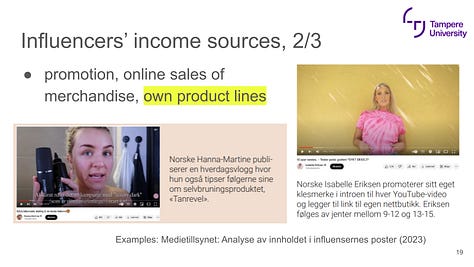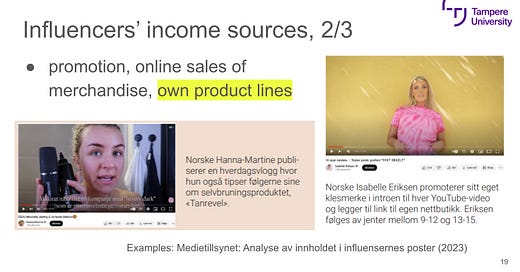Influencers increasingly endorse their own products
Children's media environment is thoroughly commercial because of social media influencers - the consumer protection agencies are increasing efforts to enforce laws
Influencers are social media content creators who commercialize their media space. We are accustomed to seeing influencers endorsing brands. A recent development seems to be towards influencers developing their own brands and endorsing their own products.
The YouTube mogul MrBeast, Jimmy Donaldson, was recently quoted in Time magazine as hoping to transition to promoting his own brands in the near future.
“Hopefully,” he says, “a year or two from now, we’re only promoting things we own.” (Time.com February 15, 2024, In the Belly of MrBeast).
The European Commission recently found that 40% of influencers endorsed their own products, services, or brands.
Similar results were found in Norway in 2022. The norwegian media authority Medietillsynet commissioned a content analysis of 22 top domestic and international influencers followed by children and youth in Norway in 2022, finding that 45% of the posts contained advertisements, the largest category being self-promotion. According to the report (Analyse av innholdet i influensernes poster, p. 21, pdf), 126 of the 369 posts containing advertising, promoted the influencers' own products and brands.
The core problem is that influencers rarely disclose commercial content. In fact, in the sweeping study commissioned by the European Commission, it was found that 60% of those endorsing their own brands failed to consistently disclose advertising.
Norway’s Consumer Authority Forbrukertilsynet, responsible for preventing and stopping illegal marketing in Norway, was involved with the EU Commission action against covert advertising. Effective October 1st, 2023, the Norwegian Consumer Protection Authority can issue monetary sanctions for covert advertising. Introducing the infringement fee means that undisclosed advertising by advertisers and influencers can have greater financial consequences than before, according to the authority website.



The EU Commission last year launched an information hub for influencers to help them comply with regulation. The chapter titled “why is this necessary” explains that more european institutions involved in consumer protection and its enforcement have undertaken extensive market monitoring and actions against those not in compliance.
If influencing a decade ago was media made by kids to other kids, out of sight by the unwitting adults, it is very much a grown-up industry today
As a scholar specializing in studying the impact of platformization on the media landscape, and more specifically, the influencer industry, these developments underscore the burgeoning significance of influencers as pivotal media actors in the contemporary media environment.
Initially, influencing was largely perceived as an informal endeavor—essentially media content created by young individuals for their peers, largely unnoticed by adults. However, it has now evolved into a mature industry, characterized by its structured marketing strategies, economic impacts, and influential power over audience behaviors and perceptions. This transition from a nascent form of peer-to-peer communication to a commercialized media sector highlights the dynamic evolution of digital media practices and their role in shaping the media landscape.



